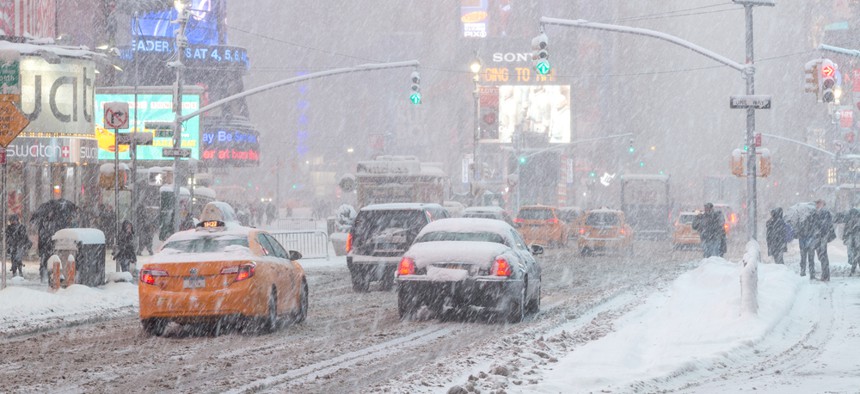Health Care
COVID storms of all types buffet New York City

Image of a snowy street in NYC during a blizzard. Shutterstock
With a deadly pandemic, economic meltdown, civil unrest and an unprecedented summertime eruption of fireworks having already plagued New York this year, literal storm clouds are now gathering force as an unseasonably strong December blizzard gets ready to slam the five boroughs and areas upstate.
New York City restaurateurs fear an estimated foot of snow will destroy expensive outdoor dining set-ups just days after indoor dining was shut down. The homeless face a dangerous night out in the cold. Even schoolchildren won’t get a break now that virtual learning has made snow days a beforetimes relic.
Looking beyond today’s Nor’easter, the onset of colder weather means people will spend more time indoors where the coronavirus more easily spreads. The ongoing surge of the COVID-19 caseloads, in turn, complicates the economic recovery from the pandemic.
The state is projecting that statewide hospitalizations will reach about 11,000 by next week – roughly two-thirds of its April apex – with thousands more deaths. Four out of five hospital beds in the city are currently occupied and Gov. Andrew Cuomo has said a shutdown of non-essential businesses would happen if state data shows that 90% of total hospital capacity would be reached within three weeks. Some elected leaders, like New York City Mayor Bill de Blasio, as well as public health experts, have suggested that the state needs to move much quicker to close non-essential businesses.
“Call me a foolish optimist, but I think New Yorkers are capable of getting us to the point where there’s no shutdown,” Cuomo said today while reiterating he does not expect any new shutdown orders until mid-January at the earliest. “I talk to 50 experts a day. Some say (COVID-19 rates) goes up. Some say flat and some say it goes down.”
Hospitalizations, daily deaths and other lagging indicators will continue to rise for at least the next few weeks even if the governor announced a stay-at-home order today that was more or less like the “pause” issued in the spring. Cuomo is still holding off on issuing new public health restrictions as he seeks to strike a balance between public health and the economic recovery from the pandemic. The first wave of the pandemic demonstrated how even a few days’ delay of a mandate can make a critical difference in slowing the virus’s spread. Plus, new vaccines are not going to make much difference anytime soon in flattening the curve once again.
A winter filled with mounting COVID-19 caseloads also brings additional side effects to the state, from the economy to the mental health of New Yorkers. While the public health crisis might still not get as dire as it was in the spring, problems like unemployment, business failures, homelessness, loneliness and ongoing uncertainty about whether public schools are opening up or closing down will continue to plague New York for some time. New public health restrictions could save lives, and tailored policies could do a lot to help businesses survive.
A new round of federal stimulus funding could also help the state get through the coming months without draconian budget cuts ripping holes in funding for health care, public schools and the social safety net. The end of the pandemic might be in sight, but only through the gloom of a winter of COVID discontent that has already arrived.

NEXT STORY: NYC jail inmates lack health care after release